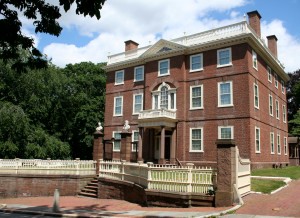John Brown House
Introduction
Text-to-speech Audio
Images
The John Brown House was built in 1788 by its namesake, who was one of the first benefactors to Brown University.

Backstory and Context
Text-to-speech Audio
The main structure was built in 1786 by John Brown. Notable guests during this time include George Washington, who is reported to have visited for tea.
The house was sold in 1901 to the prominent Rhode Island industrialist and banker Marsden J. Perry. Under Marsden's supervision, the extension was renovated to add in modern bathrooms and central heating systems. It was purchased by John Nicholas Brown in 1936.
In 1942, the Brown family donated the house to the Rhode Island Historical Society for preservation. The house was restored to its original colonial decor. The museum now contains many original furniture pieces provided by the Brown family estate and is open for public tours seasonally.
John Brown (1736 – 1803) was an American merchant, slave trader, and statesman from Providence, Rhode Island. Along with his three brothers, John was instrumental in founding Brown University (then known as the College of Rhode Island) and moving it to their family's former land in Providence. John Brown laid the cornerstone of the university's oldest building in 1770, and he served as its treasurer for 21 years (1775 – 1796). Brown was one of the founders of Providence Bank and became its first president in 1791. He was active in the American Revolution, notably as an instigator of the 1772 Gaspee Affair, and he served in both state and national government. At the same time, he was a powerful defender of slave trading, clashing aggressively—in newspapers, courts and politics—with his brother Moses, who had become an abolitionist.
Sources
Heintzelman, Patricia. "John Brown House." National Park Service - National Register of Historic Places Nomination Form. November 24, 1968. https://npgallery.nps.gov/GetAsset/329fe337-4711-4fd0-a4e9-3f44b67d42f3.
